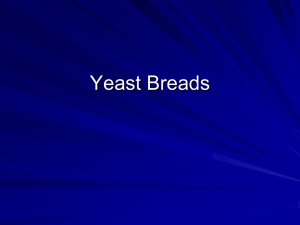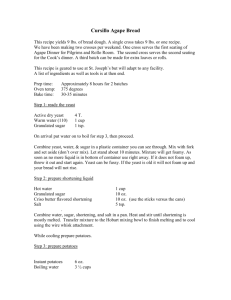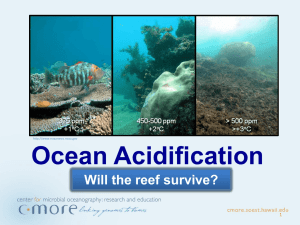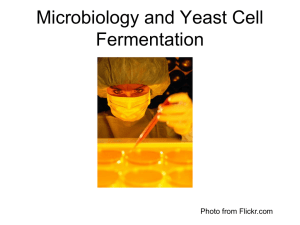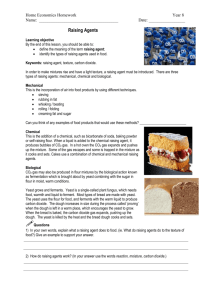Bread Basics Experiment_final
advertisement
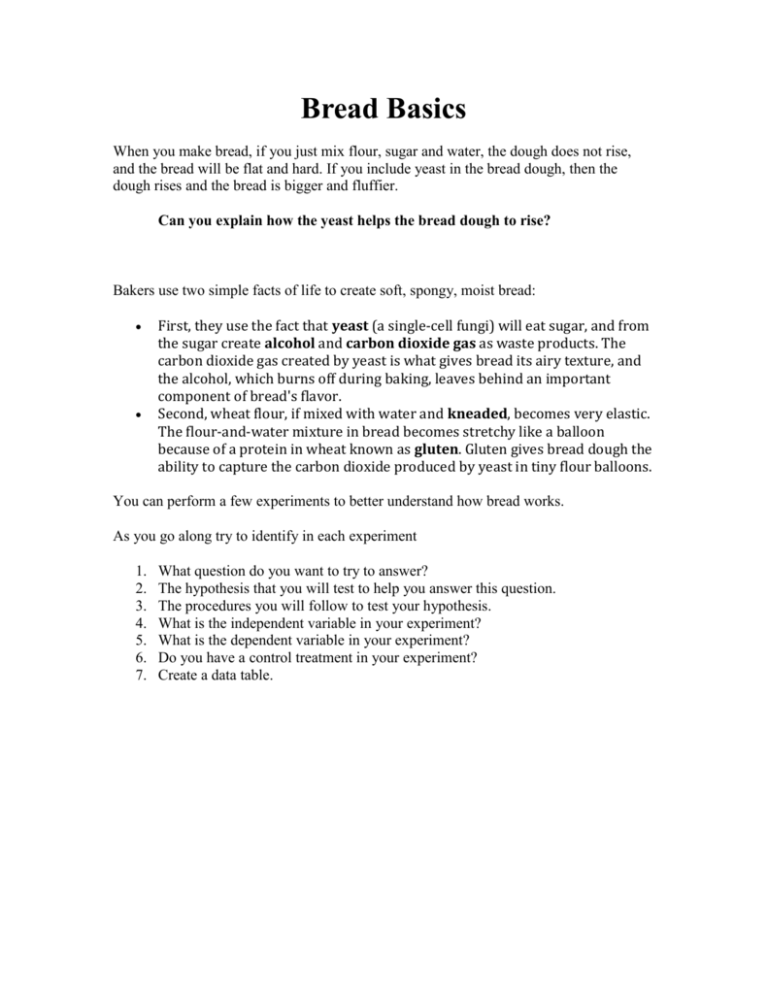
Bread Basics When you make bread, if you just mix flour, sugar and water, the dough does not rise, and the bread will be flat and hard. If you include yeast in the bread dough, then the dough rises and the bread is bigger and fluffier. Can you explain how the yeast helps the bread dough to rise? Bakers use two simple facts of life to create soft, spongy, moist bread: First, they use the fact that yeast (a single-cell fungi) will eat sugar, and from the sugar create alcohol and carbon dioxide gas as waste products. The carbon dioxide gas created by yeast is what gives bread its airy texture, and the alcohol, which burns off during baking, leaves behind an important component of bread's flavor. Second, wheat flour, if mixed with water and kneaded, becomes very elastic. The flour-and-water mixture in bread becomes stretchy like a balloon because of a protein in wheat known as gluten. Gluten gives bread dough the ability to capture the carbon dioxide produced by yeast in tiny flour balloons. You can perform a few experiments to better understand how bread works. As you go along try to identify in each experiment 1. 2. 3. 4. 5. 6. 7. What question do you want to try to answer? The hypothesis that you will test to help you answer this question. The procedures you will follow to test your hypothesis. What is the independent variable in your experiment? What is the dependent variable in your experiment? Do you have a control treatment in your experiment? Create a data table. Experiment 1 Does yeast produce carbon dioxide gas? A yeast cell can process approximately its own weight of glucose (sugar) per hour, and from the glucose (C6H12O6), yeast produces carbon dioxide (CO2) and ethanol (C2H5OH) (two molecules of each). Although yeast cells are small, there are billions of them available from the packet of yeast. Write the equation here: To perform this experiment, you will need: One large Ziploc-type freezer bag - The plastic bag should be able to hold between a couple of quarts to a gallon of water. One envelope of "rapid-rise, active, dry yeast" from the grocery store 1 cup lukewarm water (about 100 degrees F, 37.7 C) - When you stick your finger in it, it should feel neither warm nor cold. 1/2 cup sugar (How would you set up a control for this experiment? What other options can you introduce?) Let's get started! 1. Take the 1cup lukewarm water and mix the package of yeast into it. When you pour the yeast granules into the water, you allow the yeast cells to become active. 2. Mix in your sugar. 3. Pour the entire water-sugar-yeast mixture into the plastic bag. Push as much air as possible out of the bag and then seal it tightly shut. 4. Put the plastic bag in a warmish place. Come back in about an hour. What do you notice has changed in your bag? Did the yeast do a really good job of creating carbon dioxide? You should be able to see a noticeable amount of puffiness in your bag You will see that the bag has partially filled with the gas, and that the liquid is full of bubbles that the yeast has produced. Those bubbles are carbon dioxide. How can we test them to be sure they are carbon dioxide? Experiment 2 Will yeast work without adding sugar? 1. Reproduce experiment 1, but this time, replace the ½ cup sugar with a ½ cup white flour. 2. Mix the flour thoroughly into the water so there are no lumps. (This is most easily done by mixing the dry flour with a small amount of water, which will create a paste.) Slowly continue to add water, mixing it in, until all the water has been added. 3. Seal the flour-water-yeast mixture in a plastic bag as you did in Experiment one and come back in an hour or two. What you will notice is that this mixture produces carbon dioxide, but somewhat more slowly. (If you run Experiments 1 and 2 simultaneously, you will be able to see the different rates more easily.) We didn't put any sugar at all in this bag. What was the source of sugar for the yeast in Experiment 2? In the mixture of flour and yeast, there are enzymes that turn the starch in the flour into maltose, another sugar. The yeast uses this sugar in the same way it uses the glucose in white sugar. It takes time for the enzymes to convert starch to maltose, and that's what causes the delay. However, the yeast is able to produce some carbon dioxide, and that's how you know the enzymes are working. In a loaf of bread, it is this flour-to-maltose reaction that actually drives the expansion of the bread for the most part. The small amount of sugar mixed into the bread dough is used up by the yeast, fairly quickly. Experiment 3 How does the temperature of ingredients affect the fluffiness of bread? Materials (for one loaf): mixing bowl, 3 ½ cups flour, 1 ¾ Tbsp. dry yeast, 1 ¼ cups water, ¼ cup sugar, ¼ cup oil, 1 tsp. salt, clean towel For individual teams: 1cup flour, ¾ Tbsp. dry yeast, 7 Tbsp. water, 1Tbsp. sugar, 1 ½ Tbsp. oil, ¼ tsp. salt, mixing bowl and clean towel. 1. Divide students into three teams. Each team is responsible to mix up and prepare bread at one select water temperature. 2. Prepare water at three temperatures – boiling, room temperature and ice water. 3. Add yeast and sugar to assigned water temperature. 4. Wait for the yeast to proof (start to bubble). Record how long it took to start bubbling. 5. Mix in flour, oil and salt. 6. Knead the bread into a ball about 5 minutes, until smooth. 7. Place bread dough in a lightly oiled bowl covered with a towel in a warm spot to rise. (45 min – 1 hour approximately) 8. After it doubles in size. Knead again and shape into a loaf or roll and place in pan to rise again. (45 min – 1 hour approximately) 9. Bake in a preheated oven at 325 degrees for 25 minutes, until browned 10. Cool and then slice to compare texture of the bread. Did the yeast produce different amounts of carbon dioxide with different treatments? Do the results match your hypothesis? What do your results of changing the temperature or changing ingredients mean for people who make bread? Did you know that Louis Pasteur was first to describe the scientific basis of fermentation? Pasteur documented in great detail the method that allowed sugar to turn into alcohol, by way of yeast. Pasteur showed the yeast to be an organism, which did not require oxygen for fermentation to occur. This showed Justus Von Liebig who had maintained the fermentation was purely chemical, to have been mistaken. Pasteur demonstrated that mild heating applied after fermentation would kill the microorganisms and prevent souring. Pasteur was born on Dec. 27, 1822. 3rd grade physical science: Physical Science g. Students know that when two or more substances are combined, a new substance may be formed with properties that are different from those of the original materials. Investigation and Experimentation: a. Repeat observations to improve accuracy and know that the results of similar scientific investigations seldom turn out exactly the same because of differences in the things being investigated, methods being used, or uncertainty in the observation. c. Use numerical data in describing and comparing objects, events, and measurements. d. Predict the outcome of a simple investigation and compare the result with the prediction. e. Collect data in an investigation and analyze those data to develop a logical conclusion. Social Science 3.5 Students demonstrate basic economic reasoning skills and an understanding of the economy of the local region. 1. Understand that some goods are made locally, some elsewhere in the United States, and some abroad. 2. Understand that individual economic choices involve trade-offs and the evaluation of benefits and costs. 1. What question do you want to try to answer? 2. The hypothesis that you will test to help you answer this question. 3. What is the independent variable in your experiment? 4. What is the dependent variable in your experiment? 5. Create a data table.
